Beekeeping begins.
It’s been some time that we’ve known about the bees. We have an old tin shed near the road mostly got used for storage of things seldom used, a place alive with rats, spiders, surplus hardware and old tools. Vines have been trying to pry off the roof for many years and have by now mostly succeeded… yet it’s a sturdy old shed with a concrete foundation worth rehabilitating. The bees living in the walls will just have to move.
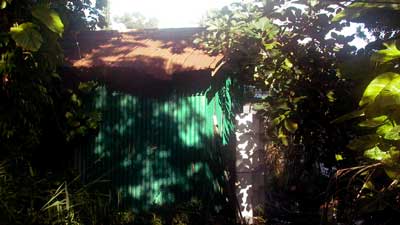 Deep in the undergrowth, the old tin shed.
Deep in the undergrowth, the old tin shed.
I don’t remember when we discovered them, but we were very excited to find the bees living here— what a blessing! The first bee man we had over to have a look was quite impressed by the size of the hive, he figured we had two huge hives in there and was very eager to help us move them out. Yet it was some time and some false starts before we arranged to meet another bee man, Alan, whom we asked to help us move the hive.
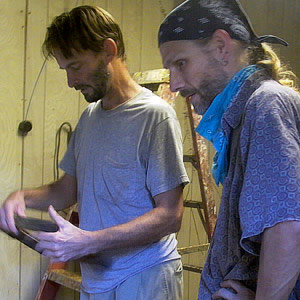 Alan and I discuss the work ahead.
Alan and I discuss the work ahead.
It turns out we do have two hives! We decided to get at one of the hives by prying off the interior paneling of the shed. On the day, he arrived early in the morning with a box and frames for us to move the hive into.
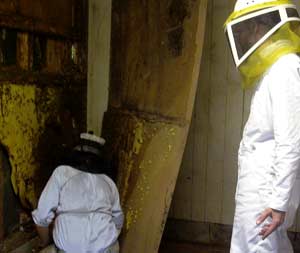 Behind the panel was a large and mostly new hive.
Behind the panel was a large and mostly new hive.
I had purchased some basic equipment to help him and to use when working with the bees… I guess I’ve become a beekeeper, although I am the greenest of beginners. I felt at ease around the bees, although I didn’t like it when one got under my veil.
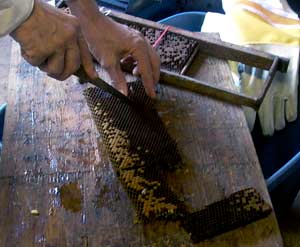 Moving the brood comb into the frames.
Moving the brood comb into the frames.
So, the way this works is we go in and get the brood cells— the ones with incubating bees inside them— and put them into a series of frames in the hive box. We try to find the queen beacause the hive won’t really move without her. Despite some very detailed and thorough searching, we are unable to locate her. All we can do is try to get as much of the brood and as many of the bees as we can into the hive. Tomorrow, we will see what the bees have done… the hive box is placed right next to the old hive so the foraging bees can continue to find it, and they will gather where the queen is.
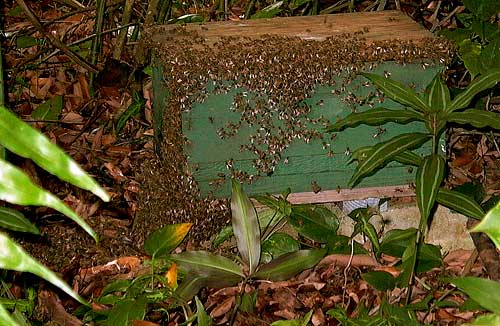 Many thousands of bees are moved into the hive box. The box contains fromes holding the brood, along with honey comb to feed the bees and all the bees we can scoop up. Most of these are young, flightless bees that tend the nest.
Many thousands of bees are moved into the hive box. The box contains fromes holding the brood, along with honey comb to feed the bees and all the bees we can scoop up. Most of these are young, flightless bees that tend the nest.
The next morning, most of the bees are in the box, so Alan is pretty sure the queen is in there. When we open the box and pull out a frame to check on the bees— there she is! A bit larger and redder than the others, she moves quickly around the frame, full entourage and all. Today is the day we harvest the honey, so we begin to cut up the beautiful yellow combs, heavy with the cured nectar of millions of flowers.
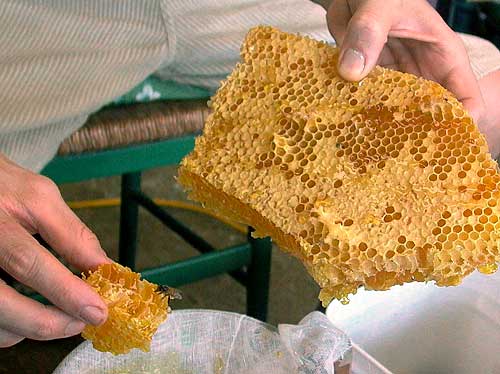 We strain the honey from the wax. We ended up with over 5 quarts.
We strain the honey from the wax. We ended up with over 5 quarts.
So, with Alan’s help and guidance, we will begin to build this hive up and should be able to collect honey, beeswax and propolis as the hive builds up a surplus. A week after moving the hive, there was evidence of extensive building activity in the hive box. It’s clear the bees have accepted their new home!
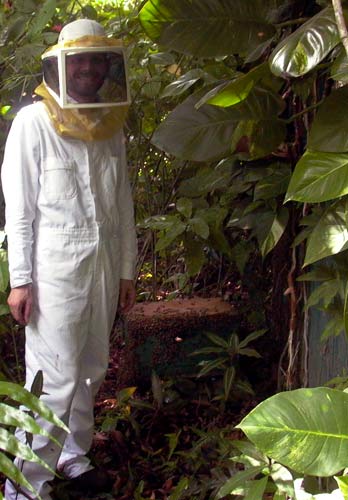 Here I am in my new bee suit, at the beginning of our beekeeping here.
Here I am in my new bee suit, at the beginning of our beekeeping here.
Next we will begin adding more space to the hive box. When I get up the nerve, I will move the other hive myself…
